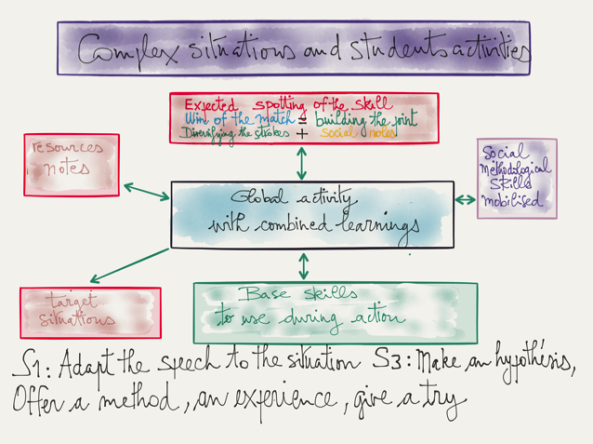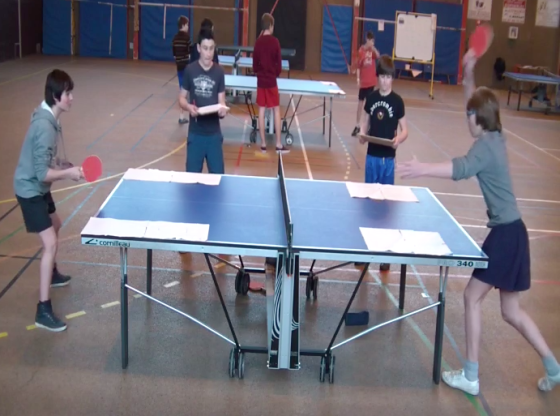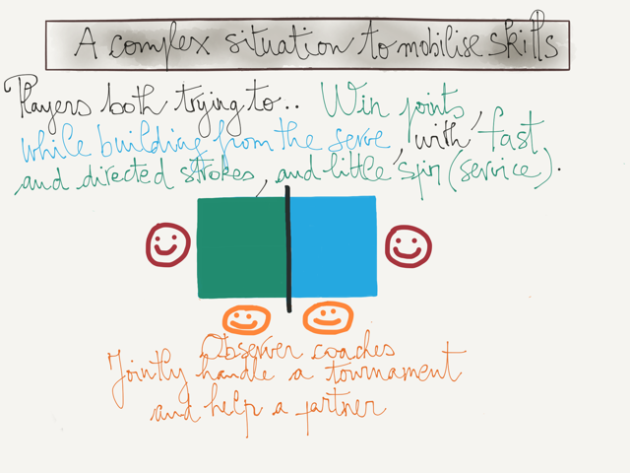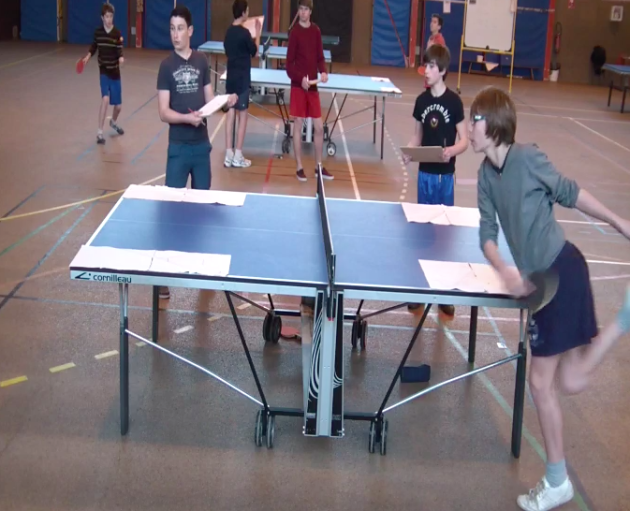Adapting in a “complex situation”
Introduction:
According to the official curriculum for Physical Education in school, attaining the level of N2 in table tennis requires that the student must be capable of:
Seeking victory in a match by building a point from the serve, breaking up the rally using strokes of varying speed and direction, and using basic spin, especially during service. Collectively managing a tournament and helping a partner be aware of his style of play in order to win the match.
Thanks to Sébastien Gabouriaud, PE teacher at the BordeauxAcademy and member of the Resource Production Group, for
the following tools:

With this table, we can locate the complex situation proposed at the heart of the educational objectives.
3 steps will then be put forward to the students:
Step 1: Putting into practice and experimenting with the play instructions (playing with position, force and spin),
Step 2: Choosing and optimising their game plan,
Step 3: Adapting this to the opponent.
1/ Step 1: Putting into practice and experimenting (playing with position, force and spin) with a possible forehand smash


Insert observation, evaluation, advice (contract), instruction tables.
Targeted Exercise 1: The forehand smash
Objective: Perform a forehand smash
Goal: Score as many “goals” as possible
Equipment and personnel required: 1 table, 4 students, 4 balls, 1 curtain behind the table (2m)
Proceedings: the 4 students are alternately player, “coach”, ball-boy and “goal-keeper”. Rotation every 2 minutes.
Instructions:
Player: Perform forehand smashes to try and reach the curtain,
Coach: Lob the balls by hand to the opponent's half-table,
Ball-boy: Recover the balls and return them to the coach,
Goal-keeper: prevent the smashed balls from hitting the curtain.
Performance criteria:
Standing sideways on to the table,
Having their feet and legs in the right position (legs slightly bent, on the balls of the feet),
Striking the ball at the very top of the bounce,
Follow through on the ball with a full, accelerated movement.
Success criteria:
Number of goals scored > 10.
2/ Step 2: Choosing and optimising the game plan (cooperation during the exercise), with a situation requiring them to serve and follow up.
Here, students have the opportunity to rally during the exercise.
They will have to follow up on their service in order to improve their chances at the start of the point (start of the game plan).
Targeted Exercise 2: Following up on the serve Objective: Build the point from the serve onwards.
Goal: Win the rally as quickly as possible.
Proceedings: 2 x 2 min match (2 min as server, 2 min as receiver)
Instructions: The server gives the receiver a position to go to before service (handicap). They can ask the opponent to come close / go long / go to the right or left of the table.
A bonus point (3 points) is given if the server wins the point by playing fewer than 3 strokes.
Performance criteria: Anticipating the opponent's reaction according to the ball hit (aim for open space to widen the gap or catch them off balance).
Success criteria: number of bonus points (won in less than 3
strokes) > 10
Here, they alternate between complex and targeted situations, learning and using these acquired skills in the game as it's built. One of the keys to the integration and progression is the close proximity of these phases to each other.
3/ Step 3: Adapting the game plan to the opponent's play. The students stop in order to comment on play during the scheduled time-outs.
The students stop play and talk about the match.
A time-out can be chosen (according to the current table tennis rules or adapted according to the target objective).
A targeted situation is proposed: the hat.
Targeted Exercise 3: The hat game Objective: Read the opponent's game (identify their strong and weak points)
Goal: Find out the opponent's instructions
Proceedings: Pull a technical-tactical constraint out of a hat, and play according to this constrain. If you manage to identify the opponent's constraint at the end of the match, you get a 5 point bonus.
Performance criteria: Identify the main characteristics of the opponent's play, either in terms of technical strokes, placement or play style, and use them to your advantage using simple reasoning (e.g. if my opponent tends to play to my backhand, then I can pivot and play a forehand smash)
Success criteria: Saying the opponent's constraint.






